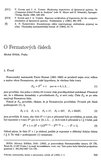Article
Full entry |
 PDF
(1.3 MB)
Feedback
PDF
(1.3 MB)
Feedback
 PDF
(1.3 MB)
Feedback
PDF
(1.3 MB)
Feedback
References:
[1] Brent, R. P.: Factorization of the eleventh Fermat number. Abstracts Amer. Math. Soc. 10 (1989), 176–177.
[2] Brent, R. P., Pollard, J. M.: Factorization of the eighth Fermat number. Math. Comp. 36 (1981), 627–630. MR 0606520 | Zbl 0476.10007
[3] Brillhart, J., Lehmer, D. H., Selfridge, J. L., Tuckerman, B., Wagstaff, S. S.: Factorization of $b^n\pm 1$, $b=2,3,5,6,7,10,11,12$ up to high powers. Contemporary Math. vol. 22, Amer. Math. Soc., Providence 1988. MR 0996414
[4] Crandall, R., Doenias, J., Norrie, C., Young, J.: The twenty-second Fermat number is composite. Math. Comp. 64 (1995), 863–868. MR 1277765 | Zbl 0823.11073
[5] Dickson, L. E.: History of the theory of numbers: Divisibility and primality. Carnegie Inst. of Washington 1919.
[6] Gostin, G. B., McLaughlin, P. B., Jr., : Six new factors of Fermat numbers. Math. Comp. 38 (1982), 645–649. MR 0645680 | Zbl 0486.10005
[7] Hardy, G. H., Wright, E. M.: An introduction to the theory of numbers. Clarendon Press, Oxford 1945.
[8] Keller, W.: Factors of Fermat numbers and large primes of the form $k\cdot 2^n+1$. Math. Comp. 41 (1983), 661–673. MR 0717710
[9] Keller, W.: Factors of Fermat numbers and large primes of the form $k\cdot 2^n+1$. II. Preprint Univ. of Hamburg (1992), 1-40.
[10] Křížek, M., Chleboun, J.: A note on factorization of the Fermat numbers and their factors of the form $3h2^n+1$. Math. Bohem. 119 (1994), 437–445. MR 1316595
[11] Lenstra, H. W.: Factoring integers with elliptic curves. Ann. of Math. 126 (1987), 649–673. MR 0916721 | Zbl 0629.10006
[12] Lenstra, A. K., Lenstra, H. W., Jr., Manasse, M. S., Pollard, J. M.: The factorization of the ninth Fermat number. Math. Comp. 61 (1993), 319–349. MR 1182953 | Zbl 0792.11055
[13] Lenstra, H. W., Pomerance, C.: A rigorous time bound for factoring integers. J. Amer. Math. Soc. 5 (1992), 483–516. MR 1137100 | Zbl 0770.11057
[14] Ligh, S., Jones, P.: Generalized Fermat and Mersenne numbers. Fibonacci Quart. 20 (1982), 12–16 . MR 0660752 | Zbl 0477.10017
[15] Montgomery, P. L.: New solutions of $a^{p-1}\equiv 1 (\operatorname{mod} p)^2$. Math. Comp. 61 (1993), 361–363. MR 1182246
[16] Morrison, M. A., Brillhart, J.: A method of factoring and factorization of $F_7$. Math. Comp. 29 (1975), 183–205. MR 0371800
[17] Pollard, J. M.: Theorems on factorization and primality testing. Math. Proc. Cambridge Philos. Soc. 76 (1974), 521–528. MR 0354514 | Zbl 0294.10005
[18] Pudlák, P.: O složitosti. PMFA 33 (1988), 20–34.
[19] Reisel, H.: Prime numbers and computer methods for factorization. Birkhäuser, Boston-Basel-Stuttgart 1985. MR 0897531
[20] Robinson, R. M.: The converse of Fermat’s theorem. Amer. Math. Monthly 64 (1957), 703–710. MR 0098057 | Zbl 0079.06303
[21] Schroeder, M. R.: Number theory in science and communication. Springer-Verlag 1990.
[22] Sierpiński, W.: Teorija liczb. Warszawa 1950.
[23] Skula, L.: Některé historické aspekty Fermatova problému. PMFA 39 (1994), 318–330.
[24] Stewart, I.: Geometry finds factors faster. Nature 325 (1987), 199.
[25] Šalát, T.: O dokonalých číslach. PMFA IX (1964), 1–13.
[26] Šofr, B.: Euklidovské geometrické konštrukcie. ALFA, Bratislava 1976.
[27] Young, J., Buell, D. A.: The twentieth Fermat number is composite. Math. Comp. 50 (1988), 261–263. MR 0917833 | Zbl 0633.10001
[28] Williams, H. C.: How was $F_6$ factored?. Math. Comp. 61 (1993), 463–474. MR 1182248

